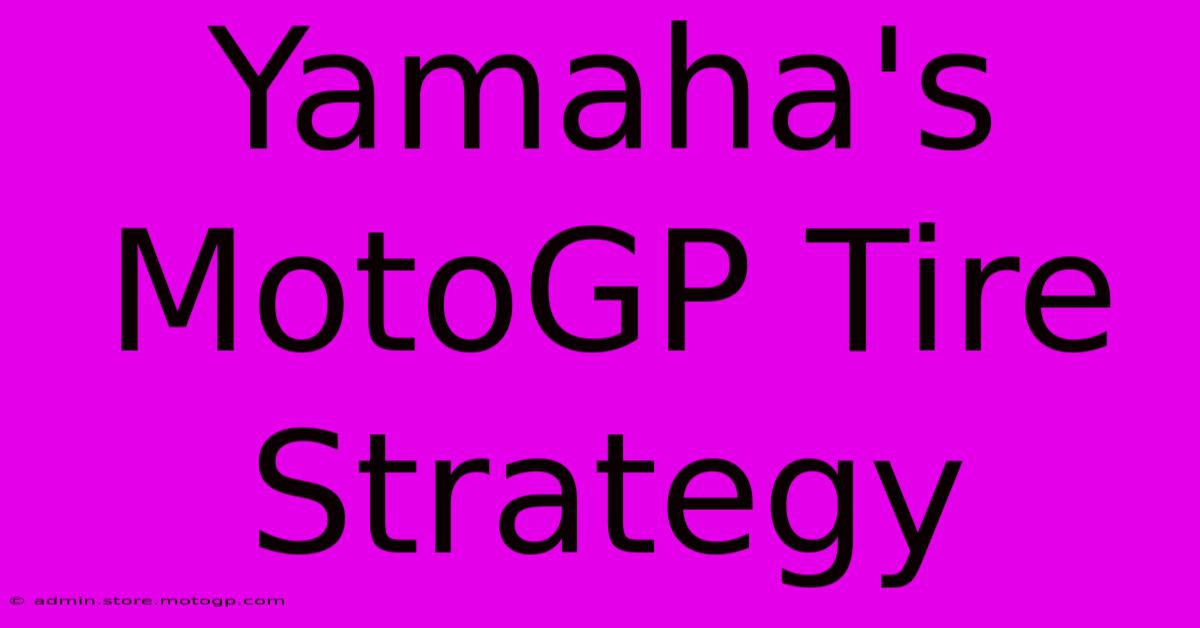Yamaha's MotoGP Tire Strategy

Table of Contents
Yamaha's MotoGP Tire Strategy: A Balancing Act of Performance and Consistency
Yamaha's MotoGP campaign is a captivating blend of raw power and meticulous strategy. While the YZR-M1 boasts impressive engine performance, tire management consistently emerges as a crucial factor determining race outcomes. This article delves into Yamaha's tire strategy, analyzing its strengths, weaknesses, and the ongoing quest for optimal performance across diverse track conditions.
Understanding the Tire Challenge in MotoGP
Before dissecting Yamaha's approach, it's important to understand the overarching challenge. MotoGP tires, supplied exclusively by Michelin, are incredibly demanding. They face immense stress from the bikes' powerful engines, aggressive cornering, and high speeds. Finding the sweet spot between outright grip and tire degradation is a constant battle, significantly impacting race pace and overall results. Different track characteristics – temperature, asphalt composition, and layout – further complicate this challenge, requiring flexible strategies.
Michelin's Tire Compounds: A Crucial Element
Michelin provides a range of front and rear tire compounds, each with varying characteristics in terms of grip, durability, and operating temperature window. Understanding which compound best suits the specific track and race conditions is paramount. Yamaha's engineers spend considerable time analyzing data and testing different combinations to optimize performance. This includes considering factors such as ambient temperature, track temperature, and even predicted weather changes.
Yamaha's Approach: A Focus on Consistency
Unlike some teams that aggressively prioritize outright pace at the expense of tire life, Yamaha often leans towards a more conservative approach. This strategy prioritizes consistency over outright speed, aiming for a strong and steady race pace that preserves tire life throughout the race distance. This is particularly crucial in races where overheating or excessive wear can lead to significant performance drops in the latter stages.
Data-Driven Decision Making
Yamaha heavily relies on data analysis to inform its tire strategy. Extensive telemetry data, gathered during practice sessions and qualifying, provides invaluable insights into tire behavior under various conditions. This data-driven approach allows the team to fine-tune the bike's setup and rider input to minimize tire stress and maximize performance. The team uses this information to determine the optimal tire choice for the race, and to advise riders on tire management techniques.
The Strengths and Weaknesses of Yamaha's Strategy
Strengths:
- Consistency: The focus on tire preservation often allows Yamaha riders to maintain a strong pace throughout the race, even on tracks that are particularly abrasive on tires. This consistency minimizes the risk of late-race collapses.
- Adaptability: While favoring a more conservative approach, Yamaha has shown a capacity to adapt its strategy based on track conditions and tire performance. They are not rigidly tied to one approach.
Weaknesses:
- Potential for Loss of Pace: The emphasis on tire conservation can sometimes hinder the ability to push for absolute top speed, especially during qualifying or in the early stages of a race. This can lead to a disadvantage in the battle for pole position and early race positions.
- Dependence on Track Conditions: The success of Yamaha's strategy is heavily dependent on track conditions being favorable to its conservative approach. On tracks that heavily favor aggressive riding styles and tire wear is less of a concern, the strategy might prove less effective.
The Ongoing Evolution of Yamaha's Tire Strategy
Yamaha's engineers are constantly striving to improve their tire management techniques. This involves refining their data analysis methods, collaborating closely with Michelin to understand tire behavior, and working with riders to improve their tire management skills. The team’s focus will remain on striking the optimal balance between performance and tire life, ensuring the YZR-M1 can consistently compete at the front of the MotoGP grid.
Conclusion: A Calculated Risk
Yamaha's tire strategy in MotoGP is a calculated risk. It prioritizes consistency and race pace over potentially higher qualifying pace and faster lap times in some situations. This approach, while not always leading to victory, reflects a pragmatic understanding of the challenges and a data-driven approach to optimizing performance across a full race distance. The ongoing development and refinement of this strategy will continue to shape Yamaha's competitiveness in the demanding world of MotoGP.

Thank you for visiting our website wich cover about Yamaha's MotoGP Tire Strategy. We hope the information provided has been useful to you. Feel free to contact us if you have any questions or need further assistance. See you next time and dont miss to bookmark.
Featured Posts
-
Sting F1 Innovation On The Track
Feb 18, 2025
-
Cota Concerts Create Lasting Memories
Feb 18, 2025
-
Arrive Relaxed Race Ready F1 Shuttle
Feb 18, 2025
-
Cota Track Day Experience The Heart Of Racing
Feb 18, 2025
-
Experience The Intensity F1 Austin Concert
Feb 18, 2025
